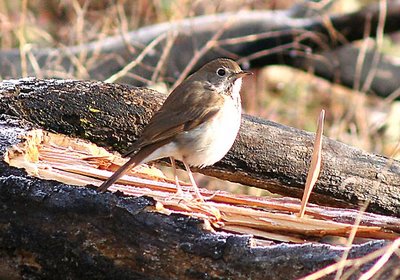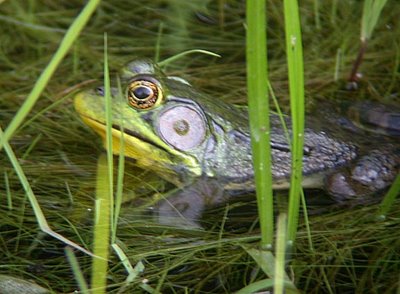Saddlebrook Bog is located in the development that bears it's name west of Montreal within the boundaries of St-Lazare. At present there is no formal public access to the area but that should change later. Part of the bog, an area that was to become a road (Bordelais), was damaged and is fenced off but it is possible to walk the periphery of the area and to enjoy adjacent habitats such as the woodland surrounding Dune Lake and the Saddlebrook Trail. Permission to develop the area further has now been refused (although a buffer zone should be considered) and the bog area is to be protected. The town of St-Lazare has plans to add a raised boardwalk, some interpretation and to aid the restoration by transplantation. A report in the local press said, rather bizzarely, that they would 'turf' part of it. I'm sure those involved cringed at that comment, you don't turf bogs.

Track on the periphery of the bog
The wildlife of the bog is rich and varied and, although the prime reason for saving the bog was an obscure little fern, the spin off is that all species using it will benefit from its preservation.
What follows is a little look at the type of wildlife found there and will hopefully inspire a few more St-Lazare people to appreciate the site.
Birds
I have been visiting part of the bog for three years and have recorded over 110 bird species. It is always a pleasure to visit and I'm often surprised by what I see. I stumbled across the site's migratory passerine potential by accident, now I try to get along there most days in spring and autumn. Ín spring the bushes can teem with warblers which pause for a day or two before pushing north. Autumn sees the return motion but the birds usually stay a little longer to build up fat reserves. The site also has breeding birds and the song of the White-throated Sparrow is probably the most familiar. Swamp Sparrows are there, as are Common Yellowthroats and Nashville Warblers. The ubiqiotous Red-winged Blackbirds are very evident as are the Common Grackles.
The photos: Birds
Ruby-throated Hummingbird - An autumn bird drinks from a leaf.
White-throated Sparrow - More often heard than seen.
Nashville Warbler - A breeding species.
Magnolia Warbler - Occurs spring and autumn on migration.
Solitary Sandpiper - Utilises small pools on the bog.
Veery - Skulking summer thrush.
Hermit Thrush - One or two pairs in the area.
Green Heron - Frogs watch out!
Chipping Sparrow - Common in summer.









Animals
The acidic waters teem with frogs and the spring chorus can be heard 500m away. Common species include Leopard Frog, Northern Green Frog and Bullfrog. Eastern American Toads lurk under rotting wood and the open water has Eastern Snapping Turtle. This prehistoric looking animal grows big and some of the the ones I see are a metre or more from tail tip to nose. In the trees Grey and Red Squirrels are present, Moles are around as are Muskrats. A nocturnal visit would certainly produce Skunk and Racoon.
The photos: Animals
Eastern American Toad - Hides in the moist bits.
Leopard Frog - Common throughout.
Bullfrog - Makes the loudest plop!
Red Squirrel - Just a red blur.
Eastern Snapping Turtle - What a beak.
Eastern Snapping Turtle - 1m long.






Butterflies
The many flowering plants in the area naturally attract butterfly species. Perhaps the commonest is the Northern Crescent. Canadian Tiger Swallowtails, Monarchs, Viceroys and the Great Spangled Fritillary are all fairly common in season.
Photos: Butterflies
White Admiral - A lazy flier.
Viceroy - A Monarch mimic.
Northern Crescent - Very common.
Canadian Tiger Swallowtail - Poetry on the wing.
Atlantis Fritillary - They never seem to land!





Dragonflies
Several species occur including the spectacular Twelve-spotted Skimmer. Often the waters and herbage will be alive with territory holding Four-spotted Chasers, all seeking food and a mate but not necessarily in that order.
Photos: Dragonflies
Four-spotted Chaser - They have four spots and they chase.
Four-spotted Chaser - a better look at those spots.
Twelve-spotted Skimmer - Truly spectacular.
Cherry-faced Meadowhawk - Showing its cherry face.
White-faced Meadowhawk - Just as nice as the cherry faced.
Widow Skimmer - A beautiful insect.






Saddlebrook Bog should become a valuable educational and recreational resource for local people. The careful and considered restoration currently underway, coupled with sympathetic access will allow future generations to enjoy it's many wonders.
I hope you liked this little Blog. The photos are all from Saddlebrook Bog and are copyrighted to me, Mark Dennis. Permission is granted for use with acknowledgement.

Track on the periphery of the bog
The wildlife of the bog is rich and varied and, although the prime reason for saving the bog was an obscure little fern, the spin off is that all species using it will benefit from its preservation.
What follows is a little look at the type of wildlife found there and will hopefully inspire a few more St-Lazare people to appreciate the site.
Birds
I have been visiting part of the bog for three years and have recorded over 110 bird species. It is always a pleasure to visit and I'm often surprised by what I see. I stumbled across the site's migratory passerine potential by accident, now I try to get along there most days in spring and autumn. Ín spring the bushes can teem with warblers which pause for a day or two before pushing north. Autumn sees the return motion but the birds usually stay a little longer to build up fat reserves. The site also has breeding birds and the song of the White-throated Sparrow is probably the most familiar. Swamp Sparrows are there, as are Common Yellowthroats and Nashville Warblers. The ubiqiotous Red-winged Blackbirds are very evident as are the Common Grackles.
The photos: Birds
Ruby-throated Hummingbird - An autumn bird drinks from a leaf.
White-throated Sparrow - More often heard than seen.
Nashville Warbler - A breeding species.
Magnolia Warbler - Occurs spring and autumn on migration.
Solitary Sandpiper - Utilises small pools on the bog.
Veery - Skulking summer thrush.
Hermit Thrush - One or two pairs in the area.
Green Heron - Frogs watch out!
Chipping Sparrow - Common in summer.









Animals
The acidic waters teem with frogs and the spring chorus can be heard 500m away. Common species include Leopard Frog, Northern Green Frog and Bullfrog. Eastern American Toads lurk under rotting wood and the open water has Eastern Snapping Turtle. This prehistoric looking animal grows big and some of the the ones I see are a metre or more from tail tip to nose. In the trees Grey and Red Squirrels are present, Moles are around as are Muskrats. A nocturnal visit would certainly produce Skunk and Racoon.
The photos: Animals
Eastern American Toad - Hides in the moist bits.
Leopard Frog - Common throughout.
Bullfrog - Makes the loudest plop!
Red Squirrel - Just a red blur.
Eastern Snapping Turtle - What a beak.
Eastern Snapping Turtle - 1m long.






Butterflies
The many flowering plants in the area naturally attract butterfly species. Perhaps the commonest is the Northern Crescent. Canadian Tiger Swallowtails, Monarchs, Viceroys and the Great Spangled Fritillary are all fairly common in season.
Photos: Butterflies
White Admiral - A lazy flier.
Viceroy - A Monarch mimic.
Northern Crescent - Very common.
Canadian Tiger Swallowtail - Poetry on the wing.
Atlantis Fritillary - They never seem to land!





Dragonflies
Several species occur including the spectacular Twelve-spotted Skimmer. Often the waters and herbage will be alive with territory holding Four-spotted Chasers, all seeking food and a mate but not necessarily in that order.
Photos: Dragonflies
Four-spotted Chaser - They have four spots and they chase.
Four-spotted Chaser - a better look at those spots.
Twelve-spotted Skimmer - Truly spectacular.
Cherry-faced Meadowhawk - Showing its cherry face.
White-faced Meadowhawk - Just as nice as the cherry faced.
Widow Skimmer - A beautiful insect.






Saddlebrook Bog should become a valuable educational and recreational resource for local people. The careful and considered restoration currently underway, coupled with sympathetic access will allow future generations to enjoy it's many wonders.
I hope you liked this little Blog. The photos are all from Saddlebrook Bog and are copyrighted to me, Mark Dennis. Permission is granted for use with acknowledgement.